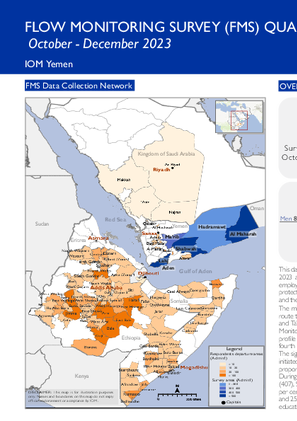-
Countries
-
Data and Analysis
-
Special Focus
-
Crisis Responses
Yemen — Flow Monitoring Survey (FMS) Quarterly Dashboard (October - December 2023)

Contact
DTM Yemen, DTMYemen@iom.int
Language
English
Location
Yemen
Period Covered
Oct 01 2023
Dec 31 2023
Activity
- Survey
- Flow Monitoring Survey
- Flow Monitoring
This dashboard compiles flow monitoring survey (FMS) data collected in Yemen between October and December 2023 and provides an analysis of migrants’ demographic and socio-economic profiles, including education and employment backgrounds, reasons for leaving their country of origin or habitual residence, future travel intentions, protection and challenges faced during the journey. Also included are migrants’ highest level of education achieved and their labour status prior to moving.
The migration routes in the southern part of Yemen are categorized along two main routes: the south-eastern route towards Shabwah, Hadramawt, and Al Maharah governorates and the north-eastern route towards Lahj and Ta’iz governorates. Both routes are travelled by a large number of migrants each year. Through the Flow Monitoring Registry tool, which focuses on total numbers of migrants (as opposed to the more detailed migrant profile established through the FMS).
DTM recorded 4,853 migrants entered Yemen through the south in the fourth quarter of 2023. This figure represents a significant decrease (-68%) compared to the previous quarter. The significant and steady decrease observed since August is likely attributed to the ongoing joint military campaign initiated to combat smuggling and secure the coastline of Lahj, a well-known governorate for receiving the largest proportion of migrants. The campaign involved deploying troops, conducting raids, and establishing checkpoints.
During the fourth quarter of 2023, a total of 2,897 surveys were conducted. In Aden (435), Lahj (636), Ma’rib (407), Shabwah (609), Hadramawt (174) and Al Maharah (636). The overall number of surveys increased by seven per cent over the previous quarter. The majority of respondents were young male adults between the age of 17 and 25 (75%) searching for economic opportunities (97%), most of whom were single (94%), attained primary education or less (61%), were currently unemployed (95%) and departed from rural areas (67%).
